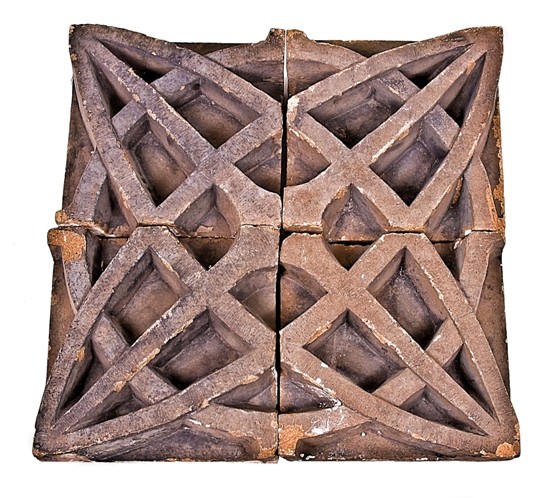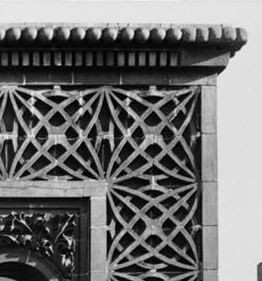
19th century schiller theater (later known as the garrick) building sectional terra cotta slip glaze “geometric flower” border panel
51-6731-10
Category
Louis SullivanAbout This Item
museum-quality 19th century all original and unrestored deep relief exterior slip glaze terra cotta border segmented or sectional panel salvaged from the schiller building’s (later known as the the garrick theater) central tower during demolition of the building in 1960. the massive exterior panel is comprised of four equally-sized sections with the loose morar and brick removed from the rear cavities (also known as “webbing”, which substantially strengthened the load-bearing capacity of the hollow terra-cotta block without greatly increasing its weight). the “geometric flower” pattern panel was thought to have been designed by draftsman (at the time) frank lloyd wright – who later occupied the 16th floor in 1893. the original cream or buff-colored glazed finish has darkened considerably due to prolonged exposure to soot and other air pollutants over the decades. the terra cotta fragment was fabricated by the northwestern terra cotta company, chicago, il. the non-extant late 19th century terra cotta-clad schiller theatre building was designed by architects louis sullivan and dankmar adler of the firm adler & sullivan for the german opera company. at the time of its construction, it was one among the tallest buildings in downtown chicago. The building’s focal point was an elaborately designed 1,300-seat theater noted for its highly organic-themed plaster ornament and remarkable acoustics. opened in 1892, the schiller theater was originally funded by german investors and was projected to be used for german-language operas and cultural events. one of the more tangible references to its german heritage was a series of terra cotta busts of prominent german figures integrated within the second story arcade. the theater changed its name and duties over the following decades. it was briefly known as the dearborn theater from 1898 to 1903, until finally settling on the name garrick theater. after german investors backed out of the project in the late 1890’s, it ceased its german performances, and exhibited touring stage shows. in the 1930’s the theater was acquired by balaban & katz and subsequently used as a television studio and movie theater. after a long decline that began during the depression, the garrick was razed in 1960 and replaced with a parking structure. the demolition instigated a large outcry and is considered to be one of the first wide scale preservation efforts in chicago. photographer and historical preservationist richard nickel spearheaded an effort to document and rescue hundreds of architectural artifacts from the building shortly before and during its demolition.








